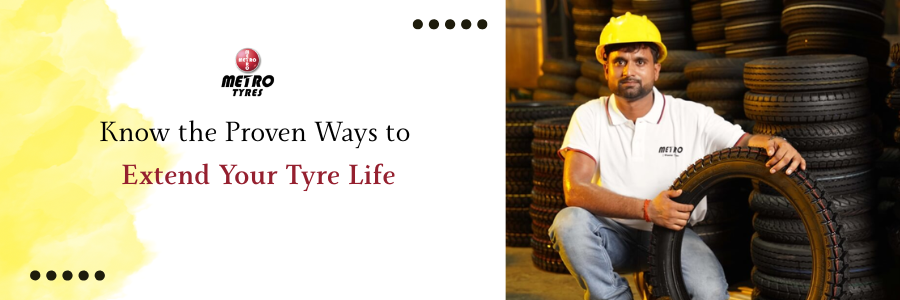Blog
Jul 05,2024
.jpg)
When you take your vehicle out for a drive, its tyres are in direct contact with the road where it faces every sort of atrocity. The more you enjoy your ride, the more these tyres wear out and put your life at risk if not looked after in time. It is not limited to just buying a car or a bike and taking it out for a spin whenever you feel like it, without paying attention to its needs from time to time. It asks for regular maintenance and check-ups.
While you make the most of your travelling needs and comfortable lifestyle, keeping your ride safe and well-maintained is also your core responsibility. And its tyres are undeniably an essential part of that responsibility that you need to take seriously. So you must know when to change them when the need arises. Hence, in collaboration with our esteemed partner Continental tyre, we have prepared this guide on ‘8 things to consider when changing your tyres’. Give it a read.
1. Wear and Tear
You should be able to observe these with the naked eye. It’s a very common sight with flat spots, abrasion, thinning of the tread, and a few more bad conditions. It is a universal sign that says your tyre needs a replacement as soon as possible. There are often chances that when the tyre is not completely worn out, but it still needs instant attention. For example, if your tyre gets worn out from the centre of the tread, it is in dire need of retirement.
2. Age of the Tyre
It is a smart and called-for decision to change your tyres once a few years, even if the usual wear and tear is not visible. For example, a car’s tyres demand a replacement every 5-6 years and a 2-wheeler tyre replacement should be at an approx. interval of 3-5 years due to its frequent uses. In due course of time, these tyres start to become brittle and dry out, eventually making them prone to occasional punctures. Other factors that contribute to the ageing of tyres include the environmental conditions and overall maintenance of your vehicle.
3. Kilometres Covered
A car requires a change of tyre after covering a fair distance of 40,000 - 50,000 km. Similarly, you need to change the tyres for your two-wheeler before it covers 30,000 kilometres. If you ask about a three-wheeler like an auto rickshaw, the changing of tyre has to be done in fewer km. than a bike or scooty as the former travels more for daily wage. To be fair and honest, best continental tyres for 3 wheeler are a good bargain for the same.
4. Frequent Punctures
Having your tyres punctured is not a reason to change it. But having them often could be one.
If you are facing flat tyres or puncture problems frequently, you need to figure out if it is happening because of the wearing out of that tyre. So if your tyre is full of puncture repairs, you need to rush to the concerned tyre dealer who can get you a good deal. Do not even think about going with it just another mile to save money and time as it may cost you more than a fortune.
5. Regular Performance
In addition to the tyre’s age, kilometres covered, air pressure, and regular punctures, you also need to pay special attention to how your vehicle’s overall performance. That also plays a significant role in determining the right time to change those tyres. If your tyres have exceeded their performance expectations, it will start showing on your vehicle’s traction, handling, alignment, and performance as a whole. Slipping of your bike or losing control of the vehicle from time to time are some more factors.
6. Weight of Vehicle
The weight of your vehicle is also a heavy factor in determining the right time to change its tyres. If you own one of those heavyweight beasts on two wheels and your bike weighs more than those of average bikes, it will definitely put more pressure on your tyres which become weaker over time. Even when auto rickshaws carry more passengers than usual, it puts more pressure on the end product- the tyre, making it prone to frequent change. You can check out Continental 3 wheeler tyres for your reference.
7. Air Pressure on Tyre
If you come across a sudden drop in the air pressure of your tyre, it simply implies that its quality has degraded and you need to change the same ASAP. There could be plenty of reasons behind it like air leaks, hidden cracks, old valve stems, or similar others. If you keep taking it for repair but still do not get the result you have been seeking, i.e. inflated tyre, chances are high that you need to get it replaced. If it is becoming much of a task to maintain the requisite pressure on your tyre, get rid of it.
8. What’s Your Budget
Now comes the most crucial aspect of going with the right tyre- the budget! To have a better idea about what should be your ideal spending on a new pair of tyres, you can always compare best continental tyre for 2 wheeler prices with others in the market and see for yourself which one suits you. But always keep this one thing in mind investing in good quality tyres should be your priority. So don’t hesitate to spend even an extra penny. At least you won’t regret spending on some cheap and low-quality product.
Conclusion
It is every vehicle owner’s worst nightmare to face the aftereffects of a tyre malfunction. So you always have to be cautious and avoid any future fatality by making the right decision at the right time. As you must have noticed above, it is basically about analysing numerous factors before coming to a conclusion that involves money and your safety as well. So whenever going tyre shopping, make sure to keep these tips in mind. And before that time comes, look after the health of your tyres with general maintenance and regular check-ups. It is not just us, but our partner, Continental tyre also wishes for your safety and security at every step.

.png)










